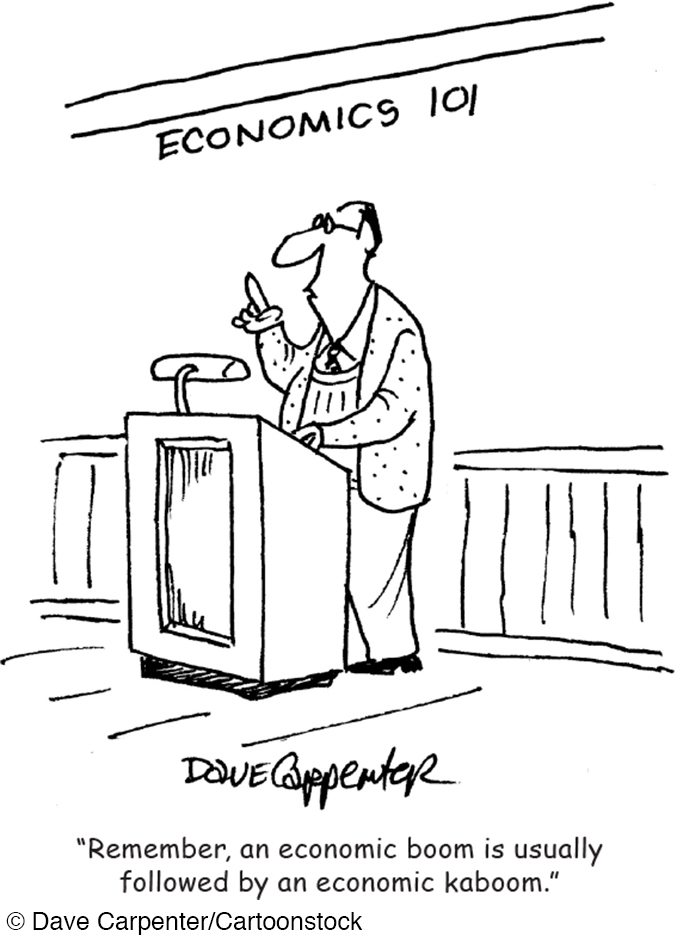1.1 The Ordinary Business of Life
Imagine that you could transport an American from the colonial period forward in time to our own era. (Isn’t that the plot of a movie? Several, actually.) What would this time-
Surely the most amazing thing would be the sheer prosperity of modern America—
An economy is a system for coordinating society’s productive activities.
Economics is the social science that studies the production, distribution, and consumption of goods and services.
The answer is that to get this kind of prosperity, you need a well-
A market economy is an economy in which decisions about production and consumption are made by individual producers and consumers.
An economy succeeds to the extent that it, literally, delivers the goods. A time-
So our economy must be doing something right, and the time-

The alternative to a market economy is a command economy, in which there is a central authority making decisions about production and consumption. Command economies have been tried, most notably in the former Soviet Union between 1917 and 1991. But they didn’t work very well. Producers in the Soviet Union routinely found themselves unable to produce because they did not have crucial raw materials, or they succeeded in producing but then found that nobody wanted their products. Consumers were often unable to find necessary items—
Market economies, however, are able to coordinate even highly complex activities and to reliably provide consumers with the goods and services they want. Indeed, people quite casually trust their lives to the market system: residents of any major city would starve in days if the unplanned yet somehow orderly actions of thousands of businesses did not deliver a steady supply of food. Surprisingly, the unplanned “chaos” of a market economy turns out to be far more orderly than the “planning” of a command economy.
The invisible hand refers to the way in which the individual pursuit of self-
In 1776, in a famous passage in his book The Wealth of Nations, the pioneering Scottish economist Adam Smith wrote about how individuals, in pursuing their own interests, often end up serving the interests of society as a whole. Of a businessman whose pursuit of profit makes the nation wealthier, Smith wrote: “[H]e intends only his own gain, and he is in this, as in many other cases, led by an invisible hand to promote an end which was no part of his intention.” Ever since, economists have used the term invisible hand to refer to the way a market economy manages to harness the power of self-
Microeconomics is the branch of economics that studies how people make decisions and how these decisions interact.
The study of how individuals make decisions and how these decisions interact is called microeconomics. One of the key themes in microeconomics is the validity of Adam Smith’s insight: individuals pursuing their own interests often do promote the interests of society as a whole.
So part of the answer to our time-
But the invisible hand isn’t always our friend. It’s also important to understand when and why the individual pursuit of self-
My Benefit, Your Cost
One thing that our time-
When traffic is congested, each driver is imposing a cost on all the other drivers on the road—
When the individual pursuit of self-
Traffic congestion is a familiar example of a much broader problem: sometimes the individual pursuit of one’s own interest, instead of promoting the interests of society as a whole, can actually make society worse off. When this happens, it is known as market failure. Other important examples of market failure involve air and water pollution as well as the overexploitation of natural resources such as fish and forests.
The good news, as you will learn as you use this book to study microeconomics, is that economic analysis can be used to diagnose cases of market failure. And often, economic analysis can also be used to devise solutions for the problem.
Good Times, Bad Times

Normally our time-
A recession is a downturn in the economy.
Such troubled periods are a regular feature of modern economies. The fact is that the economy does not always run smoothly: it experiences fluctuations, a series of ups and downs. By middle age, a typical American will have experienced three or four downs, known as recessions. (The U.S. economy experienced serious recessions beginning in 1973, 1981, 1990, 2001, and 2007.) During a severe recession, millions of workers may be laid off.
Macroeconomics is the branch of economics that is concerned with overall ups and downs in the economy.
Like market failure, recessions are a fact of life; but also like market failure, they are a problem for which economic analysis offers some solutions. Recessions are one of the main concerns of the branch of economics known as macroeconomics, which is concerned with the overall ups and downs of the economy. If you study macroeconomics, you will learn how economists explain recessions and how government policies can be used to minimize the damage from economic fluctuations.
Despite the occasional recession, however, over the long run the story of the U.S. economy contains many more ups than downs.
Onward and Upward
At the beginning of the twentieth century, most Americans lived under conditions that we would now think of as extreme poverty. Only 10% of homes had flush toilets, only 8% had central heating, only 2% had electricity, and almost nobody had a car, let alone a washing machine or air conditioning.
Economic growth is the growing ability of the economy to produce goods and services.
Such comparisons are a stark reminder of how much our lives have been changed by economic growth, the growing ability of the economy to produce goods and services. Why does the economy grow over time? And why does economic growth occur faster in some times and places than in others? These are key questions for economics because economic growth is a good thing, and most of us want more of it.
The “ordinary business of life” is really quite extraordinary, if you stop to think about it, and it can lead us to ask some very interesting and important questions.
In this book, we will describe the answers economists have given to these questions. But this book, like economics as a whole, isn’t a list of answers: it’s an introduction to a discipline, a way to address questions like those we have just asked. Or as Alfred Marshall put it: “Economics . . . is not a body of concrete truth, but an engine for the discovery of concrete truth.”
So let’s turn the key and start the ignition.
Quick Review
Economics is the study of the production, distribution, and consumption of goods and services and how the economy coordinates these activities. In a market economy, the invisible hand works through individuals pursuing their own self-
interest. Microeconomics is the study of how individuals make decisions and how these decisions interact, which sometimes leads to market failure. Macroeconomics is concerned with economic fluctuations, such as recessions, that can temporarily slow economic growth.
Check Your Understanding 1-1
Question 1.1
1. Which of the following statements describe features of a market economy?
The invisible hand harnesses the power of self-
interest for the good of society. This statement is a feature of a market economy. The invisible hand refers to the way in which the individual pursuit of self-
interest can lead to good results for society as a whole. A central authority makes decisions about production and consumption.
This statement is not a feature of a market economy. In a market economy, production and consumption decisions are the result of decentralized decisions by many firms and individuals. In a command economy, a central authority makes decisions about production and consumption.
The pursuit of one’s own self-
interest sometimes results in market failure. This statement is a feature of a market economy. Sometimes the pursuit of one’s own interests does not promote the interests of society as a whole. This can lead to market failure.
Growth in a market economy is steady and without fluctuations.
This statement is not a feature of a market economy. Although the economy grows over time, fluctuations are regular features of market economies.
Solutions appear at back of book.